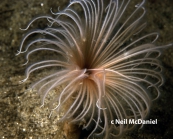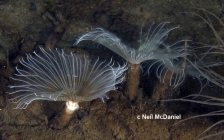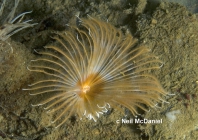
| About | | Search taxa | | Taxon tree | | Search literature | | Specimens | | Distribution | | Checklist | | Stats | | Log in |
WoRMS taxon detailsParasabella Bush, 1905
325958 (urn:lsid:marinespecies.org:taxname:325958)
accepted
Genus
Parasabella media Bush, 1905 (type by original designation)
Demonax Kinberg, 1867 · unaccepted (junior homonym, replaced by next...)
junior homonym, replaced by next synonym Distylidia Hartman, 1961 · unaccepted (subjective synonym)
Sabella (Demonax) [sensu Banse, 1979] · unaccepted (superseded recombination, taxa...)
superseded recombination, taxa split to Parasabella (replacement name for Demonax) & Bispira
marine,
recent only
Bush, K.J. (1904 (1905)). Tubicolous annelids of the tribes Sabellides and Serpulides from the Pacific Ocean. <em>Harriman Alaska Expedition.</em> 12: 169-346, plates XXI-XLIV., available online at https://www.biodiversitylibrary.org/page/22063650
page(s): 199 [details]
Note Tovar-Hernández & Harris (2010) state that...
Type species Tovar-Hernández & Harris (2010) state that Demonax krusensterni, type of Demonax, becomes type species of a revalidated Parasabella. However, this is incorrect. The respective type species do not change. [details]
Read, G.; Fauchald, K. (Ed.) (2024). World Polychaeta Database. Parasabella Bush, 1905. Accessed through: World Register of Marine Species at: https://www.marinespecies.org/aphia.php?p=taxdetails&id=325958 on 2024-09-19
Date action by
original description
Bush, K.J. (1904 (1905)). Tubicolous annelids of the tribes Sabellides and Serpulides from the Pacific Ocean. <em>Harriman Alaska Expedition.</em> 12: 169-346, plates XXI-XLIV., available online at https://www.biodiversitylibrary.org/page/22063650
page(s): 199 [details] original description (of Distylidia Hartman, 1961) Hartman, Olga. (1961). Polychaetous annelids from California. <em>Allan Hancock Pacific Expeditions.</em> 25: 1-226., available online at https://biodiversitylibrary.org/page/5214802 page(s): 129 [details] original description (of Demonax Kinberg, 1867) Kinberg, J.G.H. (1866 [or 1867]). Annulata nova. [Continuatio.]. <em>Öfversigt af Königlich Vetenskapsakademiens förhandlingar, Stockholm.</em> 23(9): 337-357., available online at http://biodiversitylibrary.org/page/32287795 page(s): 354 [details] taxonomy source Capa, María; Murray, Anna. (2015). Integrative taxonomy of Parasabella and Sabellomma (Sabellidae: Annelida) from Australia: description of new species, indication of cryptic diversity, and translocation of some species out of their natural distribution range. <em>Zoological Journal of the Linnean Society.</em> 175(4): 764-811., available online at http://onlinelibrary.wiley.com/doi/10.1111/zoj.12308/abstract note: australian Parasabella reviewed [details] Available for editors source of synonymy Perkins, Thomas H. (1984). Revision of <i>Demonax</i> Kinberg, <i>Hypsicomus</i> Grube, and <i>Notaulax</i> Tauber, with a review of <i>Megalomma</i> Johansson from Florida (Polychaeta: Sabellidae). <em>Proceedings of the Biological Society of Washington.</em> 97(2): 285-368., available online at http://biodiversitylibrary.org/page/34553607 page(s): 292 [details] status source Tovar-Hernández, María Ana ; Harris, Leslie, H. 2010: Parasabella Bush, 1905, replacement name for the polychaete genus Demonax Kinberg, 1867 (Annelida, Polychaeta, Sabellidae). ZooKeys 60: 13–19. , available online at https://doi.org/10.3897/zookeys.60.547 page(s): 14 [details]  Present Present  Inaccurate Inaccurate  Introduced: alien Introduced: alien  Containing type locality Containing type locality
From editor or global species database
Type species Tovar-Hernández & Harris (2010) state that Demonax krusensterni, type of Demonax, becomes type species of a revalidated Parasabella. However, this is incorrect. The respective type species do not change. [details]
To European Nucleotide Archive, ENA (Demonax) (from synonym Demonax Kinberg, 1867)
To European Nucleotide Archive, ENA (Parasabella) To Genbank To Genbank (from synonym Demonax Kinberg, 1867) To Genbank (from synonym Demonax Kinberg, 1867) To Genbank (from synonym Demonax Kinberg, 1867) |




